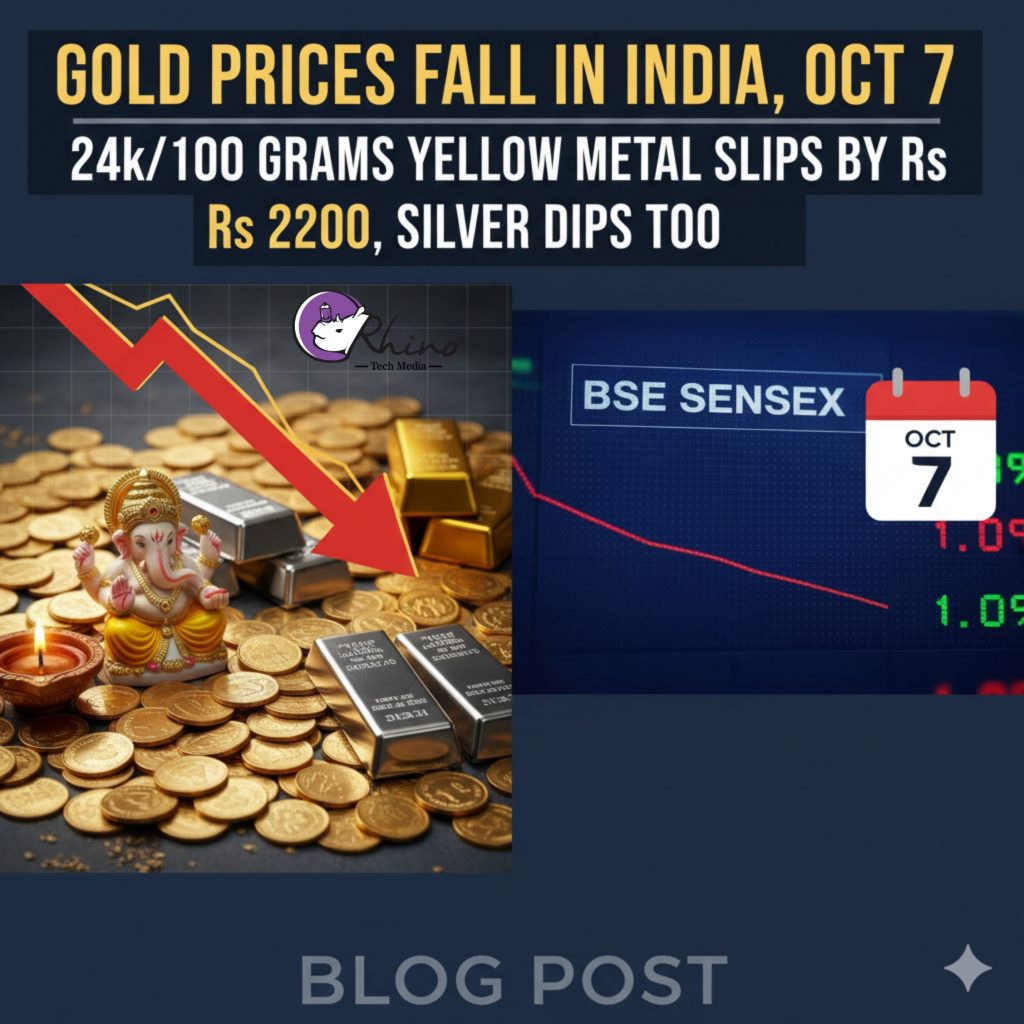Introduction
On October 7, the Indian precious metals market saw a notable correction in prices: 24-carat (pure) gold (for 100 grams) declined by Rs 2,200, while silver also recorded a fall. This movement marked a pullback after several days of rising rates and was viewed by market participants as an opportunity to reassess the price trends in the context of global and domestic macroeconomic cues.
This essay presents a structured analysis: it first lays out the price changes and their magnitude, then delves into the drivers behind the decline, discusses market reactions and implications, and finally offers a short outlook.
Price Movement: The Drop in Gold and Silver
Gold
- On October 7, 24k gold for 100 grams slipped by Rs 2,200.
- In terms of per-10-gram pricing, the drop was Rs 220.
- For lower purities, similar corrections were seen: 22k gold declined by Rs 200 per 10 grams, and 100 grams of 22k dropped by Rs 2,000.
- 18k gold also saw a drop: Rs 170 per 10 grams, translating to Rs 1,700 per 100 grams.
Thus, the pullback was broad, affecting various purities, but the headline jump was the Rs 2,200 decline in 24k/100g.
Silver
- Silver prices also fell. In 1 kg terms, silver dipped by Rs 100.
- In 100-gram units, silver declined by Rs 10.
Relative to gold’s drop, silver’s decline was milder in absolute terms, but the fall is meaningful given the already elevated base prices.
Drivers Behind the Decline
Several factors contributed to this downward movement in gold and silver prices:
- Expectations around U.S. interest rates
Reports suggested that the U.S. Federal Reserve might opt for a smaller rate cut in the upcoming meeting, supported by strong U.S. jobs data and inflation trajectories. Such expectations tend to strengthen the U.S. dollar and raise real interest rates, thereby reducing the appeal of non-yielding assets like gold and silver. - Profit booking / technical correction
After days of upward momentum, some participants likely booked profits, causing a technical pullback. In fact, the news noted that this decline followed four consecutive sessions of price rises for gold. - Global and geopolitical sentiment
While gold is often seen as a safe haven, global cues such as central bank policies, demand/supply in international bullion markets, and geopolitical risk also exert influence. Some commentary in the article cited that lingering geopolitical risks might still provide support to gold, which could limit the downside. - Currency / Rupee dynamics
Domestic gold prices are sensitive to the exchange rate of the rupee against the U.S. dollar. A strengthening rupee (or slower rupee depreciation) can reduce the rupee cost of imported gold, thereby putting downward pressure on domestic gold prices. Though the article did not deeply elaborate on the rupee’s movement, such dynamics typically play a role in India’s gold markets.
Market Reaction and Implications
- Investor sentiment
The correction may prompt cautious behavior among short-term traders, with some scaling back positions to lock in gains. For long-term or wealth-preservation investors, the dip might be viewed as a buying opportunity, especially if macro conditions remain supportive. - Jewellery demand
In India, gold has both investment and cultural dimensions (e.g., for weddings, festivals). A fall in prices could modestly revive demand, especially among price-sensitive buyers, though sharp volatility can also create buyer hesitation. - Silver vs. Gold relative attractiveness
Given that silver’s dip was smaller in absolute terms, some buyers might see it as relatively less risky at current levels. However, silver’s industrial demand sensitivity means it may face steeper swings if manufacturing slows or global demand weakens. - Support / resistance levels
The decline may test key technical support levels. If the price fails to hold support, further downward pressure could unfold. Conversely, if the gold market regains momentum, the rally could resume. Analysts will closely watch cues such as U.S. inflation, central bank commentary, and global economic data.
Outlook
Looking ahead, the direction of gold and silver prices in India will hinge on several intertwined factors:
- U.S. inflation data and Fed moves: If inflation softens and the Fed hints at rate cuts, that could provide a tailwind for precious metals. On the other hand, stronger-than-expected inflation might delay cuts, keeping pressure on gold.
- Global macro / risk sentiment: In times of uncertainty—geopolitical tensions, financial stress, currency volatility—gold may reclaim its safe-haven appeal.
- Domestic demand patterns: Especially as India enters the festival and wedding season, shifts in jewellery buying could absorb some of the downside pressure or even trigger fresh demand.
- Currency movements: Any meaningful appreciation of the rupee—or stability vis-à-vis the dollar—could dampen gold’s rupee price floor.
In summary, while the dip on October 7 carried significance, it is unlikely to herald a sustained crash unless macro conditions deteriorate sharply. More likely, we may see consolidation, selective dips, and renewed rallies depending on external cues.

